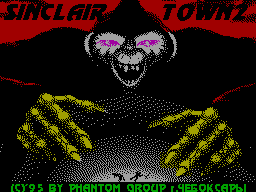|
Sinclair Town #02
31 декабря 1994 |
|
Beginners - the basic methods of image scaling: Approximation undertones.

Approximation of a semitone.
Do not be afraid of this
name. The essence of this method
very simple.
Yet at the dawn of the capitalist system (not in our
Russian), this method was used for the manufacture of textiles
products.
What is this algorithm
approximation undertones?
First, consider the method
presentation of information, called the configuration.
It is based on the fact that some pixels are combined into
configuration (usually in the form of lattices, an example
Fig. 1). Further, the entire image on the screen is constructed
using only the configuration data points.
For example, consider several configurations (square
lattice 2 * 2.3 * 3, rectangular
lattice 3 * 2).
Need to choose the configuration
very carefully, because otherwise
may have unwanted
Fine-scale structure. Not
should be chosen, for example, structures such as horizontal
lines and such as vertical lines. Figure 2 shows an example of
an unfortunate choice of configurations.
Thus, each configuration (
lattice) consists of a number of pixels and the number of
pixels in the lattice increases with
with the level of intensity (
level of the shaded
configuration).
Moreover, when the size of the lattice
M * N number of possible levels
intensity is equal to M * N +1, and
accordingly, the value set
configurations will be
also M * N +1 configuration.
That's all you need to know
on the configuration.
Now, about the method
approximation. Thus, we define (can use already
given methods), the intensity for each point representing a
grid of 4 * 4 pixel (For screen sizes: 128 * 96
points for a set of configurations
2 * 2 or 64 * 48 pixels, for a set of 4 * 4).
Then we get the proper intensity of the
configuration of points (for example,
using thresholds) and
depict it on screen. So the whole screen costs.
IMPROVING THE THRESHOLD OF METHODS.
It is evident that the use of configurations leads to a loss
spatial resolution
instead of improving the visual.
Can I somehow select a method to get some compromise?
You can, if we use the revised threshold methods. Let us
examine two of them:
A) The method of Floyd-Steinberg;
B) The method of excitation;
Consider them in more detail:
METHOD Floyd-Steinberg.
In a simple threshold method,
considered in the previous section,
there is loss of detail and texture of a weak image. This is
especially noticeable for hair and folds of clothing, as well as
its texture.
Small details are lost here
due to large output errors
intensity for each pixel. That is, we obtain a total intensity
of 13, and threshold value for the pixel painting, we had 10. In
Finally we got an error e = 1310 = 3. In the method of
Floyd-Steinberg error itself is distributed to surrounding
pixels according to the law, narisovanomu
Figure 3. Thus, if the processing point (0, 0) we have
error equal to 8, then the error
distributed at the point (0, 1) and (1, 0)
will be equal to 3, and at the point (1, 1) is e = 2.
In calculating the intensities for
these points to their total intensity will be added value
get an error. Next, we
process the point (0, 1) get an error on this for the points
(1, 1) we add to the previously obtained. Etc.
Fig.3 Distribution of the error.
Distribution of errors improves
view image details, as
lost only minimal information.
From the software point of view
This algorithm requires
buffer equal to the height of the screen when
passage points from the top down. The main drawback - the need
for real calculations. But this
method can be used with
coarse integer calculations, although it may lose all their
charm.
Method of excitation.
This method does not require any real calculation and
availability buffer. It was noted that if
in the image introduces a certain kind of random error, which
is added to the total intensity of a point to comparing it with
threshold value, the image on the screen is improved.
In this case, adding an entirely arbitrary error does not
lead to the desired result. Need a matrix corresponding to the
following requirements:
Matrix obtained by the following items:
size 2 * 2: 0 2
(Matrix of Lima) 3 1 (not p).
size 4 * 4: 0 8 February 1910
12 4 14 6
3 11 1 9
15 7 13 5
Furthermore, these matrices in a staggered
procedure adds to the image.
Other articles:
Similar articles:
В этот день... 25 November